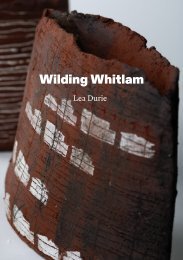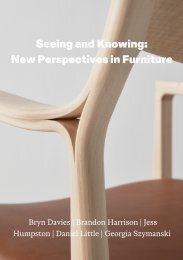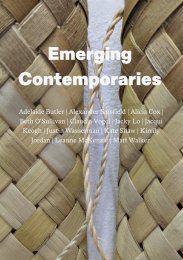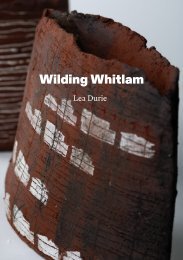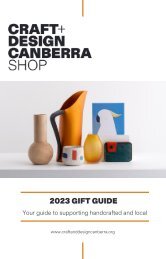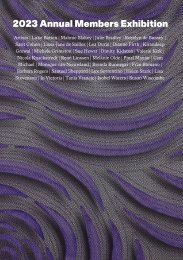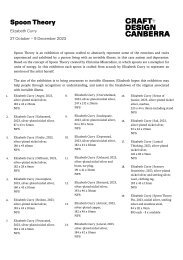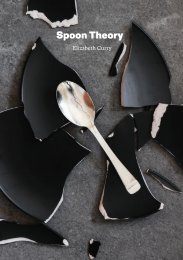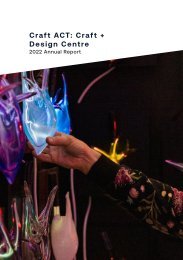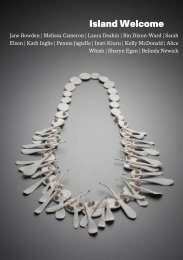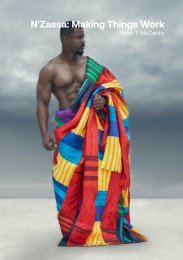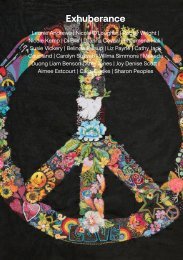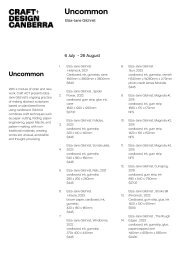Luminary: Remembering Robert Foster
Friends and colleagues from the ACT, across Australia and around the world, join Robert Foster’s family in remembering the extraordinary contribution this wonderful man made to our lives. Following the tragic accident that took his life on 13 July in 2016, Craft ACT offers a celebration, with affection and admiration, of his continuing influence as a luminary example, in every way. An imaginative and resourceful designer and maker working with metals and related materials, ‘Robbie’ (1962–2016) became well-known from the mid-1980s for his expressive and yet functional and exceptionally crafted hand-made forms, as well as for the innovative designs he developed for production through his company F!NK + Co, founded in 1994 and now operating in Queanbeyan. His many commissions include The Journey, a spectacular group of ‘ossolites’ installed in the foyer of ActewAGL headquarters, Canberra city, in 2010. Supported since 1997 by his enterprising partner, Gretel Harrison, and enthused by his daughters, Ineska and Mischa, Robert constantly experimented with ideas for new forms and processes. He believed strongly in the value of working between art and manufacture, fun and function, materials and processes, expression and sustainability. Luminary: Remembering Robert Foster is significant in that, apart from the now iconic F!NK Water Jugs,every work has been hand-made by Robert himself, as a one-off item or prototype for production. Craft ACT is especially grateful for the loan of all these unique works from the personal collection of his family. Robert also encouraged many emerging makers to work with him, and some evolved designs that were produced through the F!NK brand and identified with their names. They, and many others, acknowledge the importance of his generous mentorship in the development of their careers.
Friends and colleagues from the ACT, across Australia and around the world, join Robert Foster’s family in remembering the extraordinary contribution this wonderful man made to our lives. Following the tragic accident that took his life on 13 July in 2016, Craft ACT offers a celebration, with affection and admiration, of his continuing influence as a luminary example, in every way.
An imaginative and resourceful designer and maker working with metals and related materials, ‘Robbie’ (1962–2016) became well-known from the mid-1980s for his expressive and yet functional and exceptionally crafted hand-made forms, as well as for the innovative designs he developed for production through his company F!NK + Co, founded in 1994 and now operating in Queanbeyan. His many commissions include The Journey, a spectacular group of ‘ossolites’ installed in the foyer of ActewAGL headquarters, Canberra city, in 2010.
Supported since 1997 by his enterprising partner, Gretel Harrison, and enthused by his daughters, Ineska and Mischa, Robert constantly experimented with ideas for new forms and processes. He believed strongly in the value of working between art and manufacture, fun and function, materials and processes, expression and sustainability.
Luminary: Remembering Robert Foster is significant in that, apart from the now iconic F!NK Water Jugs,every work has been hand-made by Robert himself, as a one-off item or prototype for production. Craft ACT is especially grateful for the loan of all these unique works from the personal collection of his family.
Robert also encouraged many emerging makers to work with him, and some evolved designs that were produced through the F!NK brand and identified with their names. They, and many others, acknowledge the importance of his generous mentorship in the development of their careers.
You also want an ePaper? Increase the reach of your titles
YUMPU automatically turns print PDFs into web optimized ePapers that Google loves.
Part 3: Teapots, coffeepots, jugs and<br />
jars<br />
The process of making results not so<br />
much from a deliberate state of mind but<br />
more from the result of serendipity … The<br />
predominant driving force whilst making<br />
is to discover an object that expresses a<br />
story, an emotion, or a sense of meaning.<br />
(<strong>Robert</strong> <strong>Foster</strong>, 1997)1<br />
<strong>Robert</strong> <strong>Foster</strong> valued the personal<br />
satisfaction of making individual pieces<br />
that could be regarded as the expressive<br />
edge of his wide spectrum of practice.<br />
His interests included responding to<br />
everyday activities such as drinking tea<br />
and coffee, and the way such habits bring<br />
people together, as well as the need for<br />
containers to hold items of value.<br />
From the outset he consistently made<br />
unique hand-formed teapots that he saw<br />
as personal artwork and which did not<br />
go into production. Working around the<br />
necessary components of containers,<br />
lids, spouts and handles in new visual<br />
and functional relationships, he often<br />
integrated imaginative metaphorical<br />
references to creatures such as scorpions,<br />
raccoons, turtles and stingrays, as well<br />
as characters from the Dr Seuss books<br />
belonging to his daughters.<br />
He liked to be free of prescriptive<br />
design conventions, and valued a<br />
playful approach to serious creative<br />
experimentation: the form of Bye Bye<br />
Brontosaurus, for example, refers to<br />
dinosaur eggs. Jugs and other containers<br />
such as vessels and vases were also<br />
among <strong>Robert</strong>’s continuing passions.<br />
Some were designed to be easily lifted<br />
without a handle; on others the handle<br />
contributes to the overall design profile as<br />
well as being a functional component.<br />
Vessels might be hand-raised or formed,<br />
or press-forged under hydraulic pressure.<br />
For some, the starting point could be a<br />
tube, rather than a sheet of metal, while<br />
to put some of his hand-made prototypes<br />
into production, he introduced more<br />
complex technologies, including pressforming,<br />
water-forming and thermoforming.<br />
1. <strong>Robert</strong> <strong>Foster</strong>, in Rhana Devenport,<br />
Contemporary Vessels and Jewellery, QAG, 1997<br />
Page 16 + 18-19: <strong>Luminary</strong> exhibition, 2016.<br />
Photo: Madeline McGuigan<br />
17




